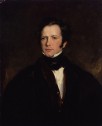Frederick Marryat

Captain Frederick Marryat (10 July 1792 – 9 August 1848) was an English Royal Navy officer, novelist, and a contemporary and acquaintance of Charles Dickens, noted today as an early pioneer of the sea story. He is now known particularly for the semi-autobiographical novel Mr Midshipman Easy and his children's novel The Children of the New Forest, and for a widely used system of maritime flag signalling, known as Marryat's Code. Marryat was born in London, the son of Joseph Marryat, a "merchant prince" and member of Parliament and his German wife Charlotte, née von Geyer. After trying to run away to sea several times, he was permitted to enter the Royal Navy in 1806, as a midshipman on board HMS Imperieuse, a frigate commanded by Lord Cochrane (who would later serve as inspiration for both Marryat and other authors). Marryat's time aboard the Imperieuse included action off the Gironde, the rescue of a fellow midshipman who had fallen overboard, captures of many ships off the Mediterranean coast of Spain, and the capture of the castle of Montgat. When the Imperieuse shifted to operations in the Scheldt, in 1809, Marryat contracted malaria, and returned to England on HMS Victorious, 74 guns. After recuperating, Marryat returned to the Mediterranean in HMS Centaur, 74, and again saved a shipmate by leaping into the sea after him. He then sailed as a passenger to Bermuda in HMS Atlas, 64 guns, and from thence to Halifax, Nova Scotia on the schooner Chubb, to join the frigate HMS Aeolus of 32 guns (27 April 1811). A few months later, Marryat again earned distinction by leading the effort to cut away the Aeolus' mainyard to save the ship during a storm, and, continuing a pattern, he also saved one of the men from the sea. Shortly thereafter, he moved to the frigate HMS Spartan, participating in the capture of a number of American ships (the War of 1812 having begun by then), and on 26 December 1812 was promoted to lieutenant. As lieutenant, Marryat served in the sloop Espiegle and in the Newcastle, and was promoted to commander 13 June 1815, just in time for peace to break out. He then pursued scientific studies, invented a lifeboat (thus earning both a gold medal from the Royal Humane Society and the nickname 'Lifeboat'). Based on his experience in the Napoleonic Wars escorting merchant ships in convoys, he developed a practical and widely used system of maritime flag signalling known as Marryat's Code. In 1819 he married Catherine Shairp, with whom he had four sons (of whom only the youngest, Frank, outlived him) and seven daughters (including Florence, his biographer). In 1820 he commanded the sloop Beaver and temporarily commanded Rosario for the purpose of bringing back to England the despatches announcing the death of Napoleon I on St Helena. He also took the opportunity to make a sketch of Napoleon's body on his deathbed, which was later published as a lithograph. (Marryat's artistic skills were modest, but his sketches of shipboard life above and below deck have considerable charm that overcomes their crudities.) In 1823 he was appointed to HMS Larne, 20, and took part in an expedition against Burma in 1824. During this expedition, which resulted in large losses due to disease, he was promoted to command HMS Tees, 28, and this gave him the rank of post captain. He was back in England in 1826. In 1829 he was commanding the frigate HMS Ariadne on a mission to search for shoals around the Madeira and Canary Islands. This was an uninspiring exercise, and between that and the recent publication of his first novel, The Naval Officer, he decided to resign his commission in November 1830 and take up writing full time.
 čeština
čeština Deutsch
Deutsch français
français magyar
magyar polski
polski русский
русский English
English Azərbaycan
Azərbaycan беларуская
беларуская italiano
italiano ქართული
ქართული қазақ
қазақ Nederlands
Nederlands português
português slovenčina
slovenčina español
español 中文
中文







